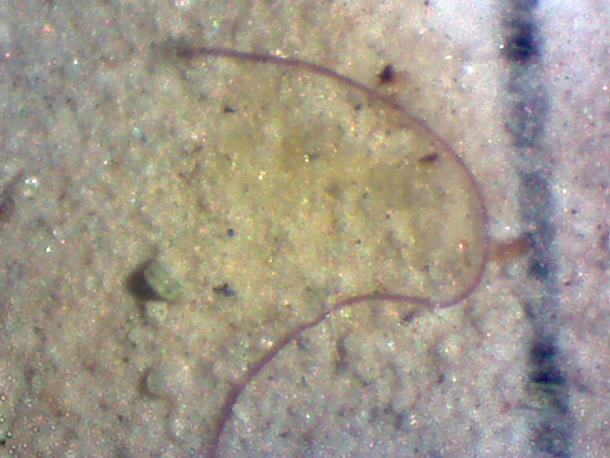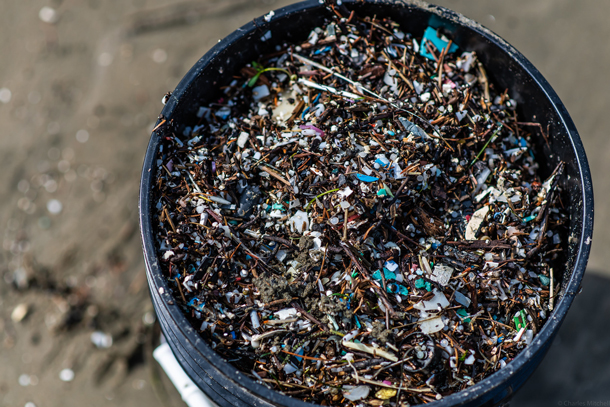Microplastics Leading to Macro-Problems
Air Date: Week of April 26, 2019

Microplastics are being found all over the globe, including in areas relatively untouched by humans. (Photo: Chesapeake Bay Program, Flickr, CC BY-NC 2.0)
Updating Kara Holsopple’s 2014 report in 2019, microbeads in cosmetics are now illegal in the US but overall, microplastic pollution is a growing threat to freshwater and saltwater ecosystems. Andrea Thompson, an associate editor of sustainability with the Scientific American, joined Living on Earth’s Bobby Bascomb to discuss how the microplastics crisis is harming people and nature, and possible solutions.
Transcript
CURWOOD: Back in 2015, Congress passed a law banning microbeads in personal care products that took effect in July of 2018. But it turns out plastic microbeads in cosmetics were only a small part of the problem. While we hear a lot about the large patches of plastics in the oceans, it is less well-known that scientists are also finding microscopic bits of plastic just about everywhere they’ve looked, including the human body. Living on Earth’s Bobby Bascomb spoke with Andrea Thompson, who wrote a three-part series about microplastics for the Scientific American.
THOMPSON: So there are both the sort of really tiny bits of plastic from things like bottles or bags that form as those bigger plastics degrade in the environment from exposure to water, or sunlight or being blown around by the wind. But there are also what are called microfibers, which are exactly what they sound like, fibers that slough off of our clothing and other fabrics that are already kind of micro-sized. And those cover not only a huge range of sizes, going from a few millimeters, to something we'd be able to see, down to things you have to have a microscope to see, as well as a whole bunch of different types of what are called polymers. So, the chemicals that make up plastic. And those are things like polyethylene, polypropylene, polystyrene, which is you know, used in foam food containers. So it's, it's really a whole bunch of different things.

Microfibers make up a large component of microplastics and often come from fabrics. (Photo: GTM NERR, Flickr, CC BY-NC 2.0)
BASCOMB: And you write that there's also now something called nanoplastics, and these can be as small as the size of a virus. Can you tell me about that?
THOMPSON: Yeah, absolutely. So it's basically the same thing as microplastics, just on an even smaller scale. And those are something that scientists are really only beginning to grapple with. Because while we can detect them in laboratory tests, where we kind of know what we're looking for, the technology isn't really there to find them in the environment. Because the existing technology can't find things that small, we really don't have a good sense of how much of that is out in the environment. But given that, basically, the smaller the size you look at, the more number of particles you find. There's a good chance that there are quite a lot of them out there that we are only touching the tip of the iceberg with what we found so far.
BASCOMB: What is the scale of the problem of microplastics and nanoplastics in our environment? I mean, it is even a knowable answer.
THOMPSON: It is to a certain extent. So it's definitely a global problem. Basically, everywhere we've looked, we found them. You know, kind of started in the oceans, including particularly in what are called gyres. So basically, where ocean currents come together and swirl around and sort of collect junk. But we've started finding them in freshwater, there's been a lot of studies, including in the Great Lakes in the US, that have found them there in concentration similar to some of these garbage patches, these gyres. They've also been found in soil. So when, when you take wastewater, the sludge that's left over from cleaning wastewater, it's really rich in nutrients, and gets applied to agricultural fields as fertilizer. Unfortunately it seems to be rich in microfibers from the US washing our clothing. And so that actually gets applied as well. So we're definitely finding that in soil. But we've also found it as far away as the Arctic, on Arctic sea ice and within it, so if it's there, it's pretty much probably almost everywhere on the planet. So it's a really complex problem to try and figure out how much of this is out there, where it's coming from, and how it's moving around the environment. And that's what scientists are really grappling with now.
BASCOMB: That was my next question. I mean, I've read that they found, as you said, plastics, microplastics, everywhere that they've looked, from sediments at the very bottom of the ocean to isolated lakes in Mongolia. I mean, how are they getting there?

Plastic pollution is a major problem from the macro to micro scale. (Photo: Emilian Robert Vicol, Flickr, CC BY 2.0)
THOMPSON: So we're still kind of working that out. You know, with the ocean, really it all originates from land, because that's where we live. And we're the only creatures that use plastic. In terms of the ocean, some of its washing from rivers, some of it might be coming from landfills, or things that are on coasts. Could be, you know, kind of just blowing off into the water. There is growing research to show that these microplastics are being carried around in the atmosphere. And that's one of the key ways they may reach some of these really remote places where there isn't a lot of human habitation to explain why there might be plastic. So that would tend to probably be stuff on the smaller range, and especially microfibers, because their shape just kind of naturally lends well to wafting in the air. You can see it if you're sitting and looking at a shaft of sunlight. And you notice the little things that particles of dust, some of that is probably microplastics and microfibers. Not all, and we don't know exactly the proportions yet. But those are some of the ways it's getting around as sort of following these natural air and ocean currents and rivers and things like that.
BASCOMB: A lot of us have probably seen these photographs of whales and fish with their guts just full of larger pieces of plastic. And they eventually kind of die of starvation since there's no room left over for food. But how did microplastics impact the health of marine animals that digest them.
THOMPSON: So we're still figuring that out a little bit. And they're a little different from these bigger plastics, because they are smaller in size. They have been found, in marine creatures is mostly where we've looked, but also some fresh water aquatic creatures. My belief, at least some laboratory experiments, things like earthworms can eat them too. So that brings it back to the terrestrial side. Some of the concerns for that are that they could rub against basically, you know, the gut lining, and cause irritation, inflammation that could lead to other health problems for these creatures. And if they're small enough, that they might actually get absorbed through the gut lining and get into the bloodstream, which has been shown that it can happen, we're not really sure how widespread that is. And the worries there are also that all of the other chemicals that are in these plastics, the things that get added to them, you know, either a coloration or what are called plasticizors, that make them more moldable, those could get introduced into animals this way, into the bloodstream if they're getting absorbed. So those could eventually maybe impact the reproductive ability of the species. And there has been some experimental evidence that shows that, at least in some species, introduced a certain types of microplastics that you do see, you know, declines and reproduction, and that that actually goes on to subsequent generations. So it's not just the fish that ingested the microplastics, but it's that fish’s children too.
BASCOMB: And what about people that eat fish that are full of microplastics, is that a concern?
THOMPSON: So it's a little bit of a concern, from what I've talked to from most people, because at least in fish, we haven't seen a lot of widespread evidence that it is, a lot of this micro plastic is getting outside of the gut into the wider tissue of the fish. So if most of it is getting trapped in the gut, we don't really eat the guts of fish. So most of it, we wouldn't be exposed to. Now, with shellfish like scallops and things, that's not the case, we might be exposed there. But it is clear that we are ingesting and likely inhaling microplastics from the air. There was another study actually, very recently, that looked at human stool samples and found pieces of microplastic in it. So that was some of the first direct evidence that we're definitely ingesting it. And then with inhalation, is enough of it small enough that it could penetrate deep into the lungs.

Microplastics have even been found in soil. (Photo: Surfrider Foundation Oregon Chapter, Flickr, CC BY-NC-ND 2.0)
BASCOMB: So an obvious thing we need to do here is just produce less plastic to begin with. And a lot of cities are looking to do that either banning single use plastic grocery bags and straws, things like that. How far will that get us though, towards addressing this problem?
THOMPSON: Yeah, so pretty much everyone I've talked to who studies plastic pollution in general, but microplastics specifically too, has said, you know, bans are fine, but they're really only a starting point. They won't come as close to addressing the larger issue of the scale of the amount of plastic we produce. And they often don't target production directly, you know, so if one city bans them, the company that's making those bags might just shift their, you know, market to somewhere else. And that market may not have as good a waste system, as you know, a city in the US. So is that really the best way to do it? And there's also the consideration of what alternatives is that pushing people towards. If it just means we're doing more paper bags, or you know, everyone gets an organic cotton tote that comes with a lot of land use, fertilizer use, water use, you know, what is actually the best alternative. Another is that PET is one of the most recyclable, it's probably the only part of the plastic recycling system that is profitable, and really works really well. And that's the stuff that you know, water bottles and soft drink bottles are made of. The problem is, if you, say, introduce coloring to that, that makes that plastic less desirable to the recycler, it's harder for them to deal with. And that coloring isn't there for any food safety reason, it's a marketing thing. So we're taking one of the most recycled plastics and rendering it less valuable by adding coloring to it that isn't really necessary. So there are even little things like that that can make a big difference in terms of how much actually gets recycled.

Andrea Thompson is an associate editor of sustainability with Scientific American. (Photo: Courtesy of Andrea Thompson)
BASCOMB: Now that we have an idea of the scope and the potential danger of this problem, I mean, what in the world can be done to clean up the microplastics that are already so ubiquitous in the environment?
THOMPSON: Most people that I talked to have said, at least in terms of addressing micro plastic pollution, the key is to stop stuff from getting into the environment, just to turn off the tap of things that are getting in there. Because right now, with any cleanup we can do, we can't clean it up as fast as it's going into the environment. So we'd be playing a constant game of catch up. So it's better to tackle the introduction and just stop new stuff from getting in there. And you know, that's going to take a dedicated look from lawmakers to figure out what are the things that are actually going to have kind of the most bang for our buck.
CURWOOD: Andrea Thompson is an associate editor of sustainability with the Scientific American. She spoke with Living on Earth’s Bobby Bascomb.
Links
Scientific American | “Earth Has a Hidden Plastic Problem—Scientists Are Hunting It Down”
Scientific American | “Microplastics Are Blowing in the Wind”
Living on Earth wants to hear from you!
Living on Earth
62 Calef Highway, Suite 212
Lee, NH 03861
Telephone: 617-287-4121
E-mail: comments@loe.org
Newsletter [Click here]
Donate to Living on Earth!
Living on Earth is an independent media program and relies entirely on contributions from listeners and institutions supporting public service. Please donate now to preserve an independent environmental voice.
NewsletterLiving on Earth offers a weekly delivery of the show's rundown to your mailbox. Sign up for our newsletter today!
 Sailors For The Sea: Be the change you want to sea.
Sailors For The Sea: Be the change you want to sea.
 The Grantham Foundation for the Protection of the Environment: Committed to protecting and improving the health of the global environment.
The Grantham Foundation for the Protection of the Environment: Committed to protecting and improving the health of the global environment.
 Contribute to Living on Earth and receive, as our gift to you, an archival print of one of Mark Seth Lender's extraordinary wildlife photographs. Follow the link to see Mark's current collection of photographs.
Contribute to Living on Earth and receive, as our gift to you, an archival print of one of Mark Seth Lender's extraordinary wildlife photographs. Follow the link to see Mark's current collection of photographs.
 Buy a signed copy of Mark Seth Lender's book Smeagull the Seagull & support Living on Earth
Buy a signed copy of Mark Seth Lender's book Smeagull the Seagull & support Living on Earth

